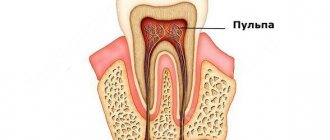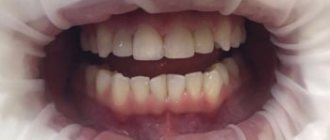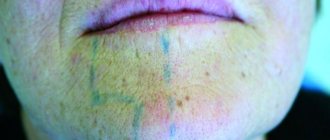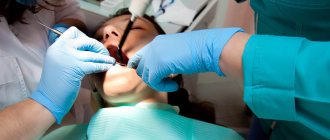Often, removal of the dental nerve, or pulp, is a necessary measure in the treatment of advanced dental pathologies. The procedure is quite complex, so it should only be performed by a qualified dentist with extensive practical experience.
To avoid medical errors and complications, contact the Mitino Dental Center. Our doctors know how to painlessly remove the nerve of a tooth and prevent its premature destruction.
Why is it necessary to remove a nerve?
Removal of the dental nerve is required in advanced inflammatory processes that affect both soft and hard tissue structures, including the pulp.
The most common reasons:
- periodontitis,
- pulpitis,
- benign neoplasm near the root,
- deep pulpal caries.
Depending on the type of pathological process and the size of the affected area, removal is carried out with partial preservation of the pulp or complete preservation from all canals. Amputation of part of the nerve is usually used for dental caries. In other cases, complete removal is usually necessary.
When is dental nerve removal required?
Nerve removal is a procedure after which the tooth is deprived of sensitivity. It stops responding to any irritants, including sour, sweet, salty, bitter, cold and hot.
Removing a nerve from a tooth deprives it of blood supply, and therefore the ability to receive all the necessary elements, mineralization processes slow down significantly, and in some cases, it all depends on the characteristics of the organism, a change in its appearance may be observed: the enamel will fade, the tooth itself will become more fragile.
However, in some cases, pulp removal is the only possible method of tooth treatment.
Estetik Art dentists recommend removing a nerve from a tooth in the following cases:
- In case of severe trauma to the tooth , when the enamel is chipped so that the nerve is affected.
- If pulpitis is diagnosed . Inflammation of the nerve can begin as a result of advanced caries.
- In preparation for prosthetics . Depulping a tooth may be necessary when installing orthopedic structures, according to the opinion of an orthopedic doctor.
At the Aesthetic Art clinic, tooth nerve removal is performed for both adults and children. We use safe and effective anesthetics that will make the procedure safe and painless.
Pulp - what is it for?
The pulp is a fibrous connective tissue penetrated by nerve endings and blood vessels.
Its shape completely follows the tooth, and is located in the center of the root part, filling the entire cavity. On top, the pulp is protected by a hard enamel layer, which prevents injury from the outside.
Main functions of the dental nerve:
- responsible for the formation, proper growth of teeth and blood supply;
- protects channels from pathogenic microbes;
- supplies the tooth with useful micro- and macroelements.
In addition, the pulp is responsible for the sensitivity of the tooth, that is, for its reaction upon contact with hot, cold, sour, sweet, and so on.
Reference! The dental pulp in adults is thinner than in children. This is due to age-related changes and a slowdown in regeneration processes. The older a person is, the thinner and weaker the nerve becomes, and the tooth begins to experience a deficiency of nutrients.
Possible risks when removing the nerve of a tooth
Removing the nerve of a tooth and then filling the canals requires a lot of experience from the dentist. Patients who have developed inflammation after poor-quality filling by an inexperienced specialist come to our clinic. The most common consequences of poor quality work are:
- Tool breakage. Removing the tooth nerve and cleaning the canals is carried out with very thin instruments, so the slightest careless movement can lead to the instrument breaking off. In most cases, after the instrument breaks off, the tooth must be removed. It is almost impossible to save it.
- Bleeding. Bleeding during nerve removal is immediately noticeable. But when using a pulp extractor it can be quite strong.
The risk of breakage and bleeding is less when modern instruments are used during the procedure. To remove the nerve, we use files, electronic devices to control the operation, and in difficult cases, a microscope.
Probably the most common medical error that occurs is poor quality cleaning of the canals after nerve removal. In such cases, residual pulpitis develops. If the process is started, pulpitis can spread to the root. As a result, periodontitis develops.
After tooth nerve removal, pain is normal. But they should completely go away within a few days. If a long time has passed since the operation and the pain does not go away, consult a doctor immediately.
A tooth may hurt after nerve removal for various reasons:
- Poor cleaning of dental canals. If the nerve was not completely removed, the source of inflammation remains.
- The wrong size instrument was selected to remove the nerve. In this case, there is a risk of injury.
- A secondary focus of inflammation has developed. Infection can occur due to poorly sealed canals. Relapse can also occur if the nerve was not completely removed.
- Allergy. Sometimes the patient may have an individual intolerance to medications or filling materials used to remove the nerve.
You should consult a doctor in any case. We recommend not delaying the visit, as this will increase your chances of saving the tooth. If there are indications, our doctor will prescribe a refilling for you. This is a more complex operation, as you will first need to unfill the tooth and remove the gutta-percha.
Our clinic employs dentists who have the necessary qualifications and extensive experience in performing endodontic operations. In addition, the clinic is well equipped. We use modern diagnostic equipment, high-quality tools and consumables in our work. All this helps us successfully perform nerve removal and root canal treatment.
Is it painful to remove a nerve?
It is difficult to say for sure how much a tooth hurts after nerve removal, since much depends on the person’s pain threshold. The depulpation procedure itself is performed under anesthesia. First, the doctor treats the injection site with special painkillers, and only after that introduces local anesthesia. It turns out that the process is painless from start to finish.
Pain may occur after the anesthetic wears off. The cause of discomfort is cleaning the canals, which injures soft tissues. If the procedure is performed by a qualified doctor, usually the tooth after nerve removal only hurts during the first day, then the pain gradually decreases.
Removal procedure
There are several methods for removing the nerve, it all depends on the specific case. When a doctor decides how to remove a nerve from a tooth, he takes into account several factors:
- Condition of a particular tooth: type of disease, degree of tooth destruction, indications for pulp removal and causes;
- The general health of the patient, including age, presence of chronic diseases;
- Technical equipment of the clinic, available instruments;
- Arsenal of medicines.
At the Aesthetic Art clinic, they prefer the fastest, least painful and safe method of depulpation without the use of arsenic, surgical removal of the nerve under local anesthesia. This treatment takes place in one or two doses, depending on the complexity of the particular case.
How long does the nerve removal procedure take?
The duration of the procedure depends on the degree of neglect of the pathology. On average, anesthesia takes about 5–15 minutes, and root canal treatment takes about 30–40 minutes. Sometimes medicine is placed into the cavity and closed with a temporary filling, and at the next visit it is replaced with a permanent one.
This method is rarely used, most often in cases of severe damage to multi-rooted teeth. For single-rooted individuals, one visit to the dental office is usually sufficient.
Important! Independent removal of a temporary filling is strictly prohibited. This leads to infection of the open canal, which is extremely dangerous not only for the oral cavity, but also for the entire body.
Stages:
- X-ray. This is a mandatory step in removing a nerve from a tooth when pulpitis is suspected or diagnosed. This allows the doctor to make the correct diagnosis and avoid various complications and troubles during the nerve removal procedure;
- Anesthesia. When treating pulpitis, local anesthesia is used. In this case, the patient will not feel pain at all, and will only guess what the doctor is doing
- Preparing the work area. Until the anesthesia takes effect, the doctor cannot begin the treatment procedure, but is already actively preparing for it. To do this, the tooth that will be prepared is isolated as much as possible from the healthy oral cavity. For this, cotton-gauze swabs can be used with the obligatory use of saliva ejectors, or a rubber dam can be applied;
- Opening the pulp chamber , removing tissues affected by caries, providing convenient access to the root canals. At this point, the doctor uses special equipment that helps to quickly and effectively remove all affected areas of the tooth;
- Removing a nerve from a tooth . The complexity and duration of the procedure depends on which tooth requires treatment, as well as the individual characteristics of the body, the structure and location of the root canals;
- When the nerves are removed, the doctor widens the canals,, if necessary, removes the affected areas and tissues, and then rinses with active antiseptics . This is necessary for the treatment to be effective and for there to be no relapses;
- Filling canals is one of the most difficult and critical stages of work. It is the quality of the work performed that determines how long the tooth will last. All channels are filled with filling material to the very base; the formation of voids is not allowed. For careful monitoring, the doctor takes final or intermediate x-rays;
- After filling the canals, a filling is placed on the crown of the tooth. The type and type of filling depends on each specific case.
The nerve removal procedure can be modified according to your doctor's instructions. Treatment of pulpitis in children often extends over several visits, since it is very difficult for young patients to sit in the doctor’s chair for 1.5-2 hours in a row.
Stages of treatment
First of all, the patient is sent for radiography. Diagnostics allows you to determine how many roots a tooth has and choose the most appropriate method of treating the pathology. The following describes the algorithm of actions for removing pulp in one session.
- Anesthesia. First, the injection site is treated with a special agent, after which an anesthetic is administered and left for about 5–15 minutes.
- Preparing the tooth for depulpation. To extract the pulp, it is necessary to provide access to it. To do this, the doctor opens the crown part of the tooth and then removes all affected tissue.
- Removal of the dental nerve. For these purposes, special instruments are used that quickly remove pulp from both the coronal and root parts.
- Installation of a seal. Depending on the location of the tooth, certain filling materials are used for filling - composites, dental cement, etc. Sometimes the doctor will place a temporary filling to ensure that the removal was completed correctly. In this case, a second visit will be required, during which the condition of the tooth is assessed, the temporary filling is removed, and then a permanent one is installed.
With complete removal, the pulp is removed from the coronal and root parts. If the inflammation has affected only the top of the tooth, partial depulpation is performed. In this case, only the coronal part is cut off, and the pulp in the area of the root system remains intact and fully retains its functions.
To make an appointment, call us at the phone number listed on the website. The specialist will answer all your questions and suggest the most convenient time to visit the doctor.
Does it hurt or not?
Since the pulp consists of more than 20% nerve endings, it is very sensitive to even light touches. That is why a disease such as pulpitis (inflammation of nerve endings) is always accompanied by severe pain. As a result, the tooth becomes very sensitive to any kind of irritant.
Because of this, any interventions and nerve removal are carried out only under local anesthesia. Otherwise, the patient simply will not be able to tolerate the discomfort. Today it is customary to distinguish two groups of indications for surgery to remove tooth nerves: therapeutic and orthopedic. Therapeutic ones assume the presence of pathology in the pulp, for example, developing deep caries, inflammatory processes in the root of the tooth (periodontitis), damage to deep tissues by stones, severe injuries to the jaw, etc.
In addition, dentists often talk about the need for pulp removal before upcoming orthodontic treatment, installation of crowns or dentures. Orthopedic indications include the presence of a risk of developing inflammation in the pulp chamber, severe curvature or tilt of the tooth, which does not make it possible to grind the crown, low coronal part, etc. In all these cases, removal of the nerve is a mandatory procedure before starting treatment, but the final decision is always made by the attending physician.
Cost of tooth nerve removal
The price of tooth nerve removal depends on the complexity of the clinical picture. The final cost is affected by:
- The degree of development of pulpitis. In the initial stages, partial removal of the nerve can be done. This operation will be cheaper.
- Number of channels. It is more difficult to treat a tooth with multiple irregularly shaped canals. Jewelry precision is required from a doctor. The difficulty of removing the nerve will increase the final price of the procedure.
- Method for removing the nerve of a tooth. The doctor chooses the appropriate method for removing the nerve of the tooth individually.
- Consumables used. We use high-quality consumables, so we can guarantee hermetically sealed canals.
- Number of doctor visits. The number of procedures required to remove the nerve and treat the canals depends on the complexity of the case.
If you have a toothache, sign up for a consultation at the Zuub.rf clinic. During the initial visit, the doctor will perform a visual examination, make a preliminary diagnosis and prescribe instrumental diagnostics. Based on the results of the examination, the doctor will tell you what procedures need to be performed and calculate the cost of the procedures.
How does the procedure work and how long does it take?
Procedure steps:
- Dental examination. The doctor collects the patient’s medical history, complaints, and assesses the condition of the tooth.
- X-ray. The specialist sends the patient for an x-ray. The image determines the condition of the periodontium and pulp, as well as the number, shape and length of the dental canals.
- Anesthesia. Before the anesthetic is administered, the patient is tested for sensitivity to the drug.
- Depulpation. The dentist opens the tooth and either removes the pulp mechanically or applies an arsenic paste. In the first case, after removing the nerve, the doctor moves on to the next stage. In the second, he closes the tooth with a temporary filling and sets a date for the patient’s next visit.
- Cleaning and filling of canals.
- Control photo. This is a required step. Using the image, the doctor checks whether the canals are tightly sealed and whether the filling material has not gone beyond the root.
- Installation of a temporary filling for 10–14 days. If during this time the patient has no complaints, the temporary filling is replaced with a permanent one.
In total, removing the nerve and filling the canals takes from one to one and a half hours.
Some dentists immediately place a permanent filling, but this is a rather risky step. Two weeks is a control period during which complications may appear. If this happens, the filling will have to be removed and a new one placed after treatment. This is an additional expense for the patient.
How to remove a nerve in a tooth
There are two methods of depulpation - mechanical (vital) and chemical (devital).
In the first case, the nerve is removed immediately after opening the tooth. The doctor uses special instruments and mechanically removes the pulp from the roots, after which he cleans the canals and seals them. If there is no need to inject anti-inflammatory drugs into the canals for periodontal treatment, nerve removal and canal filling are carried out in one step.
The devital method is used less frequently. Devitalization involves removing the pulp using chemicals. After opening the tooth, a paste containing arsenous acid, paraformaldehyde or trioxymethylene is applied to the neurovascular bundle. These substances necrotize the dental nerve. Then a temporary filling is placed. At the next appointment, the doctor removes the “dead” pulp, cleans and seals the canals.
In what cases is depulpation required?
There are a number of specific indications for removing the dental nerve:
- Deep caries, in which the pathological process has spread to the soft tissues of the tooth and caused inflammation of the pulp - pulpitis;
- Periodontitis is inflammation of the periodontium;
- Trauma to the tooth, as a result of which the neurovascular bundle is exposed.
All these conditions are accompanied by acute toothache, turning into aching pain. The tooth reacts to cold, hot, sweet. With periodontitis, the tooth may hurt when biting or pressing.
To relieve pain, prevent inflammation from spreading to other tissues and save the tooth, the dentist removes the pulp and fills the root canals with filling material.
In some cases, the doctor depulps the tooth before installing a crown. Previously, in such situations, the nerve was always removed. Modern methods of treatment and prosthetics make it possible not to depulpate a tooth if there are no objective indications for this.
There are certain contraindications to the procedure:
- Acute leukemia;
- Infectious diseases in acute or chronic stages;
- Inflammation in the oral cavity.
It is not recommended to remove pulp in patients:
- With chronic diseases of the cardiovascular system;
- With mental disorders;
- Pregnant.
In these cases, the dentist makes the decision about depulpation after consultation with a specialized specialist or the patient’s attending physician.










